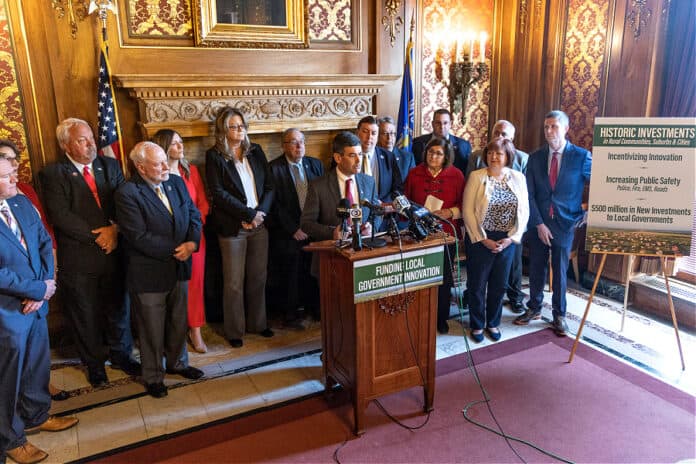There’s a pretty genius conservative wish list baked into the Wisconsin state Assembly’s shared revenue plan.
The press conference in Milwaukee on Thursday came with very unusual imagery: Milwaukee’s Mayor Cavalier Johnson and County Executive David Crowley standing with Assembly Leader Robin Vos and other Republican leaders at a podium. And getting along. What that means, though, is that Vos and other leaders GOT MILWAUKEE TO AGREE to a host of things conservatives will love. Strategic brilliance.
How? Because Milwaukee has a looming pension liability and massive budget gap and, legitimately, the shared revenue formula was outdated and, local communities say, broken. Shared revenue (the amount the state gives to local governments) has dropped but inflation rose; one community even toyed with the idea of shutting off every other street light. The only critic who really emerged out of the gate was Waukesha County Executive Paul Farrow, but even his biggest criticism was that he wanted Waukesha County to get more money.
But rather than give away the store when they changed the shared revenue formula, Republican leaders used Milwaukee’s desperation because of its pension boondoggle to play hardball. One could flip the rhetoric and say that perhaps Johnson and Crowley are more reasonable than conservatives give them credit for, or, at least, they’re more reasonable than political animal Tom Barrett. Granted, that’s not saying a lot.
Vos said the plan represents the “single largest investment in local governments in the history of Wisconsin” and stressed it was bipartisan. Local governments, all of them, will each see at least 10% boosts in shared revenue, and it could grow if the sales tax grows. The funding will come in part through a portion the state sales tax.
The City of Milwaukee and Milwaukee County could create new sales taxes as part of the plan, which would be 2% for the city and a .375% expansion for Milwaukee County, if they can get voters to approve them in referendums. However, if conservatives don’t live there, they don’t have to pay it. Most of that will have to be used for the city’s pension obligations and public safety resources, like police, fire and EMS.
Milwaukee Mayor Cavalier Johnson called Vos a “tough negotiator,” and Vos praised Johnson for being collaborative.
Here are 10 easter eggs in the plan that conservatives might appreciate:
-
Milwaukee can’t defund the MPD!
Defund the police is over, at least in Milwaukee, if the plan is approved. Vos said the plan would ensure “no further cuts in police and libraries.”
The plan requires that the number of sworn officers on the force stays at 1,630, which it is now and it will grow to 1,725 over time. This means city officials are AGREEING to not cut the number of sworn officers more
Vos said that “one of the best parts of the deals” is a requirement that will ensure the number of Milwaukee police officers will not go down. He called that a “huge benefit for the state.”
As Wisconsin Right Now previously reported in 2021, the number of sworn officers in the Milwaukee Police Department dropped almost 18% between 1995 and that year. Meanwhile, Milwaukee has seen record homicide numbers. Thus, to be clear, the city has already decreased the number of officers on the force. But the new plan stops the bleeding.
Part of the bill restores about 100 police officer positions over the next few years, in addition to more investments in public safety, said Andrew Wagner, president of the Milwaukee Police Association, in a press conference. He praised the plan, saying that it puts an emphasis on investments in public safety and should increase safety in Milwaukee. He praised state legislators and said the proposal had bipartisan support.
-
The Milwaukee street car can NOT expand
Vos also revealed that expansion of the Milwaukee street car “would not be allowed” under the plan.
But here’s the kicker. We’ve also learned that the plan would not allow EXISTING public dollars to expand the street car. That means it’s stopped unless some private grant emerges, which is unlikely.
-
The Milwaukee Fire and Police Commission will have a cop and firefighter on it, for sure!
The Milwaukee Fire and Police Commission will see changes empowering the police chief, not the commission, to make policy decisions in consultation with the mayor and Common Council.
But just as important, the Commission, frequently filled with anti-police civilian appointees chosen by the mayor, will now have at least two mandated positions for appointees who have served as a police officer and firefighter.
The police and fire unions will nominate three people for each slot, and the mayor will pick from those three.
That’s a big deal for public safety in Milwaukee because the civilian-appointed commission includes some anti-police, far-left members who notoriously mistreated prior police chiefs (Read: Alfonso Morales.)
-
Elimination of the personal property tax
The personal property tax is being eliminated, Vos said, calling it an “onerous tax for small businesses. Of the plan, Vos said: “We eliminate a tax in a bipartisan way.”
-
No business closures for more than 14 days if another pandemic hits, without a vote
The plan prevents local public health officers from shutting down businesses for more than 14 days if there’s another pandemic.
The local government would have to vote every 14 days if there are closures. Now, public health officers, who aren’t elected, make those calls.
-
Milwaukee can’t spend ANY NEW money on diversity, equity and inclusion positions
The City of Milwaukee can’t use the new money on diversity, equity and inclusion positions, Wisconsin Right Now has learned.
Milwaukee County’s provision didn’t go as far, but they agreed not to discriminate in contracting and hiring.
For the city, it’s strong. No more DEI with public dollars – that means tax levy dollars, not just new money.
-
Protecting access to quarries to reduce roadbuilding costs
Republicans believe local governments need easy access to road and stone to reduce the cost of construction. That means quarries.
But NIMBYS (not in my backyard folks) have tried to stop them. The plan changes how governments can regulate quarries to make it easier to get the product and stop NIMBYs.
8. Towns and rural areas benefit big!
Townships, which are often rural with conservative voting populations, are being financially caught up with how cities and villages have been financed.
Although everyone benefits by 10% at least increases in shared revenue in the plan, the largest percentage increase will go to communities with populations under 30,000 – which means rural areas and small towns, which are often conservative.
Prior to the plan, cities and villages got more money than towns because when shared revenue was created, towns didn’t play as much of a role with fire and police and EMS services as they do now.
-
Changes to local government operations on new programs & budget cuts
Under the new plan, you have to have a 2/3rds of a county board or common council to create new programs.
When they submit a budget, they will have to detail what 5% cuts would look like so the public has a better understanding of what’s at stake.
-
An innovation fund
Millions of dollars will be available through an innovation fund if communities agree to find ways to share services and become more efficient.
Of course, Gov. Tony Evers would need to sign the legislation for it to become law. The state Senate would also have to approve the Legislation. Also genius: It will be presented in a separate bill from the budget, so Evers can’t do line item vetoes. He can’t strike out the easter eggs!
But with a long line of local officials, including prominent Democrats in Milwaukee, supporting the plan, how does Evers get away with stopping it?
Table of Contents







![Protecting Portland: No Good Deed Goes Unpunished [REVIEW]](https://www.wisconsinrightnow.com/wp-content/uploads/2025/07/portland-356x220.jpg)























